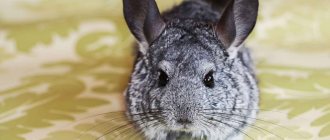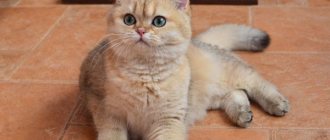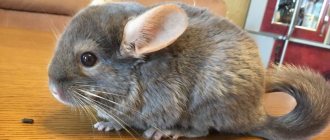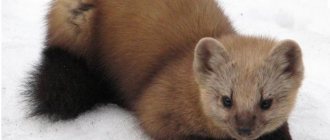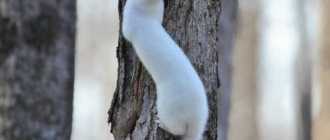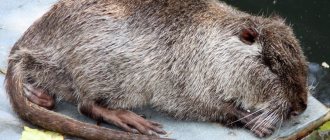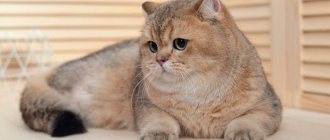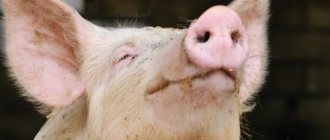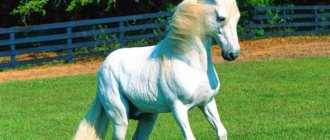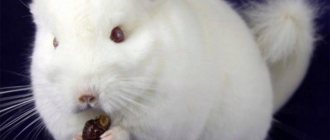Chinchillas are small animals from the order of rodents native to South America. Their habitat is the highlands of the South American Andes. Currently, there are very few chinchillas left in the wild; these animals were hunted for their fur, as a result of which the species is on the verge of extinction. Since the middle of the last century, chinchillas have been bred by amateurs as pets.
The chinchilla was first described by the English zoologist Edward Bennett in 1829.
Chinchilla - description and external characteristics
In appearance, the chinchilla resembles a large squirrel (they weigh from 300 to 800 g, and males are smaller than females), but in terms of its method of movement it is more like a rabbit. They have very thick, thin and soft fur, large dark eyes and large ears. The ears are the only organ of chinchillas that helps reduce body temperature - they are covered with a dense network of capillaries.
The body length of chinchillas is from 22 to 38 cm, the tail is 10-17 cm. The hind legs are longer than the front legs, thanks to which their movement resembles the jumping of a rabbit. Number of toes: four on the hind limbs, five on the front limbs. The front legs can make grasping movements.
The number of teeth reaches 20, and they grow throughout life. Therefore, it is very important for chinchillas to be able to chew something.
Baby chinchillas have white teeth, but adult chinchillas have orange teeth.
Interesting facts about the rodent:
Chinchilla looking at the camera
- The word "chinchilla" comes from the name of the Peruvian province of Chincha, which is located in Peru.
- The vocal behavior of chinchillas is very interesting. If they don't like something, they make a sound that resembles a quack or chirp. Very angry chinchillas begin to growl and, as it were, “blow their nose,” quickly clicking their teeth. If the animal gets hurt or gets very scared, it begins to squeak loudly. When threatened, chinchillas attack, stand on their hind legs, growl and let out a stream of urine, and then can grab the offender with their teeth.
- The use of chinchillas as a source of valuable fur in Europe and North America began in the 19th century, but a high demand for their skins still exists today. You need to spend about 100 skins on one fur coat, which is why chinchilla fur coats are the rarest and most expensive. For example, in 1928, the cost of a chinchilla coat was half a million gold marks. And in 1992, a chinchilla fur coat cost $22,000.
- The long-tailed chinchilla is kept as a pet and is also bred for fur on special farms and in private households. The fur of the long-tailed chinchilla is grayish-bluish in color, very soft, thick, and durable. The short-tailed chinchilla's fur is of slightly lower quality.
Where do chinchillas live in the wild?
Chinchillas are found in the wild in the dry mountainous regions of Bolivia, Argentina and Chile. In these zones, the temperature in summer does not exceed +24 C, and in winter it drops to -20 C. The climate is dry, windy and cold. It is thanks to these living conditions that chinchillas have very valuable and thick fur.
The vegetation in the area where wild chinchillas live is quite sparse. Mostly cacti, shrubs, some cereal plants and herbs grow there. Such living conditions affected the diet of these animals. Their incredibly long intestines allow them to extract nutrients from fairly meager food. In an adult animal, the length of the small and large intestines reaches 3.5 m. Wild chinchillas feed only on plant foods: branches and bark of shrubs, succulents, dry herbs and leaves.
Chinchillas live in groups and are nocturnal. Up to hundreds of animals can live in one group. During the day they hide in natural shelters, such as crevices in rocks or in burrows dug by other animals. To protect against predators, the colony always has “observers” who warn the whole family about the danger with loud sounds.
Chinchillas are nocturnal animals, their large eyes and long sensitive whiskers (vibrissae) allow them to move unerringly in the dark.
In natural conditions, chinchillas form pairs. They produce one offspring per year. There are usually 2-4 cubs in a litter.
Unfortunately, at present the number of wild animals is very small, only about ten thousand. In 2008, the long-tailed chinchilla was declared a critically endangered species. And the short-tailed chinchilla, unfortunately, is an endangered species.
Reproduction
Chinchillas reach sexual maturity at the age of 6-9 months, with females maturing earlier than males. Despite the fact that rodents live in colonies, mating occurs with one permanent partner.
The first rut begins in the spring. The gestation period lasts a little more than 3 months. During this time, the female noticeably gains weight, and just before giving birth, she practically stops moving. 2-3 cubs are born in one litter. The animals are born sighted, they have teeth and are covered with fur. The female feeds the babies with milk for up to two months, but already on the 2-3rd day they begin to try plant foods.
Females give birth 2-3 times a year. Re-coating by the male occurs almost immediately after birth. Despite the ability of chinchillas to produce offspring several times per season, reproduction of the species does not occur as intensively as in other rodents due to the small number of litters.
Animals reproduce well in captivity. Thanks to many years of breeding work, it was possible to obtain many varieties with different fur colors. Today on chinchilla farms you can find individuals with a standard gray color, as well as beige, silver, white, black, brown, and purple. The rarer and more difficult the color mutation to obtain, the higher the price of the chinchilla.
What sounds do chinchillas make?
In nature, chinchillas live in groups and have developed a way of communicating with sounds. Their range ranges from a soft and quiet purr to a sharp whistle:
- mating rumbling calls of the male to mate;
- squeaking of babies - a demand for mother's attention or food;
- protest - sharp sounds that chinchillas make when quarreling or warning of danger;
- Chinchillas make very sharp and high-pitched sounds when angry, in a state of severe fright or when feeling pain.
How many years does a domestic chinchilla live?
Chinchillas are unusually active animals; they really like to jump, run and play. Life expectancy in captivity depends on how they are kept. How long can a chinchilla live at home? If you pay attention to their diet, keep the animals in a spacious cage, and give them the opportunity to communicate and move, then they can live quite a long time: eight to ten years or more.
Breed classification
Chinchilla is one of the representatives of the rodent order. Chinchillas in nature are small, long-tailed and coastal. The habitat of this animal is rocky terrain.
Currently, there are about 14 chinchilla breeds and 12 interbreed species.Main color: light, dark and gray, the most popular color is dark with a light zone at the roots.
Character
By nature, chinchillas are very affectionate and tame; they almost never bite. The animal can bite only in a state of severe fright. All chinchillas are different, some like to be petted and others not so much, and these character traits need to be respected. What chinchillas do not tolerate is violence. In order to achieve mutual understanding with the animal, you need to show patience and persistence, and respect the peculiarities of its character and behavior.
After purchasing a chinchilla, you need to leave it alone for about a week and let it get used to its new place. Then, unpersistently, you need to extend your hand to her with a treat. If the chinchilla wants, she will come up, take the treat and climb into your arms. If not, you need to continue taming it day after day until the animal gets used to you.
A chinchilla may become offended if you leave it alone for a long time or simply do not pay attention to it. She won't want to play with you and won't even take treats from your hands.
Chinchillas are very good at manipulating their owners. They know exactly what needs to be done to get what they want: they will sit in a corner and look at you with sad eyes, or they will jump on their hind legs to get a treat or go for a walk around the room.
Does a chinchilla have intelligence?
Fluffies are undoubtedly smart and quick-witted. They know how to skillfully manipulate their owners, begging for a treat or another walk.
Cunning pets quickly realized that people cannot be indifferent when they see an offended expression on their faces and rush to hand them a treat or open their cage. Taking advantage of this weakness, the pet deliberately pretends to look pitiful and touches the bars of the cage with its fingers.
Such magnetic charisma emanates from animals that it is impossible to resist.
Is it possible to train a chinchilla to go to the litter tray?
Chinchillas are very smart and learn quickly. It is very easy to train them to go to the litter box: place it in the cage in the place where the animal usually goes to the toilet, you need to remove all the bedding and wipe the floor of the cage with lemon. The chinchilla will immediately understand what needs to be done.
Tray
The second method: at first allow the animal to go to the toilet on the entire bedding at the bottom of the cage, but gradually reducing it every day. When a small patch remains, replace it with a small tray. The main thing is to change the bedding every day so that the cage is always dry.
Chinchilla girl or boy, who is better?
If you have never kept these animals at home, then it is difficult to say who will be better for you: a boy or a girl chinchilla. Females of this species are usually more active and dominant. But if you only need one animal, just choose the one you like best. After all, they all have not only different appearances, but also different characters.
Perhaps, having got yourself one animal, you will want to find a mate for it so that it does not get bored in your absence. Knowing the characteristics of behavior and maintenance and how to determine the gender of a chinchilla, you will be able to choose the right partner.
These animals are monogamous and usually form a pair for life. We must also take into account that in chinchilla “families” there is always a matriarchy, so the male chinchilla usually submits.
Chinchilla color
The natural color of chinchillas is gray, but not uniform; they have a dark back and a white belly. The color can vary in saturation from light gray to almost black.
Amateurs have bred numerous color variations: white, black, beige, brown and others. There are also purple chinchillas, although their color is not exactly purple, but gray with a bluish or light purple tint. In total, there are about 240 different shades of domestic chinchilla color.
White-pink color
Tricolor color
Golden color
Completely black color
Purple color
How to determine the gender of a chinchilla
If you decide to have this animal at home, it is better to know in advance how to distinguish a female chinchilla from a male. You may want to have babies, or perhaps, on the contrary, you will decide to have one or a pair of rodents of the same sex so that they simply do not get bored, but you are not planning on having babies.
So that there are no surprises, and the animal that, in your opinion, a male chinchilla, does not bring unplanned offspring, approach the choice of a pet responsibly.
How to distinguish a boy from a girl chinchilla by appearance? It's easier with adults.
These animals have pronounced sexual dimorphism. This means that individuals of the same species differ significantly in appearance. The male chinchilla is significantly smaller and weighs less. If the average weight of a female is 800 g, then a male chinchilla weighs approximately 600 - 700 g.
Therefore, you can distinguish the sex of a chinchilla even by eye, if there are many of them and they are adults. It’s just that the chinchilla girl is larger and more active. And even more aggressive towards boys. So you can notice differences in behavior.
But with small cubs, problems may arise in how to distinguish a female chinchilla from a male. You can simply find on the Internet the genitals of chinchillas in the photo and their description.
There is no need to determine gender if the animal is not feeling well or is not in the mood. After identification, be sure to treat the chinchilla and stroke it to calm it down.
Diet
Chinchillas are quite delicate animals, and their diet at home must be selected very carefully. What do chinchillas eat? The main food for them is dry hay (it must be properly dried, with a pleasant herbal smell).
Fresh, high-quality hay should always be in the cage. If there is not enough hay, the animal may die.
In addition to hay, the chinchilla is fed with special food, and the following are suitable complementary foods: cereal flakes, dried leaves, herbs or roots, corn and flax seed, dried pieces of vegetables. These animals happily gnaw on branches of fruit trees and bushes: apple, cherry, raspberry or currant trees. The main thing is that everything is dry and free of moisture.
Chinchillas need to be given water. Make sure the water is always fresh.
A responsible attitude to the selection of chinchilla nutrition prolongs their life; more than half of the animals die prematurely from intestinal disorders.
Keeping at home
Keeping and caring for chinchillas at home is not difficult. But there are some important conditions that must be adhered to. Chinchillas need spacious, wide cages, preferably high ones, similar to enclosures; the animals are very active and must move a lot. For one animal, a cage of the following dimensions is suitable: 100 cm high, 80 cm long and 50 cm wide.
Chinchillas love to climb to heights, so it is advisable to give them this opportunity by installing wooden shelves in the cage. There is no need for ladders to connect floors, as chinchillas love to jump. In addition to shelves, it is advisable to install in the cage: a spacious wooden house, hammocks, tunnels and a running wheel.
Chew toys are also needed. These could be: small branches, wooden blocks, salt or chalk stone.
When choosing a cage, pay attention to the presence of plastic parts; they should not be in the cage, because... chinchillas chew and eat everything, and plastic can cause intestinal obstruction and death of the animal.
In addition, the chinchilla needs to be let out of the cage for a couple of hours a day, but at the same time monitored, since they like to chew everything that comes their way, including wires and furniture.
The bottom of the cage can be left clean, without filler, and in the corner of the cage you can install a tray where the chinchilla will go to the toilet.
Chinchillas are strictly prohibited from bathing in water! To clean their coats, they bathe in sand. Sand for this purpose should be used very fine and clean.
A container of sand can be placed in and next to the cage several times a week. There is no need to leave it on for a long time, as bathing chinchillas too often can cause dry skin.
If there is no filler at the bottom of the cage, then the cage should be swept daily with a small broom, removing excrement. It is advisable to wipe the shelves daily with natural detergents.
From whom did they come?
The prehistoric ancestors of chinchillas are considered to be animals called Meegamys by scientists. Their fossilized remains were found during excavations in the habitats of modern rodents. The age of the finds is about 40 thousand years. The biological structure of Meegamys is similar to chinchillas, but their size is much larger.
Based on the results of the excavations, a hypothesis was built that explains not only the origin of chinchillas, but also the unique properties of the animal’s fur. According to the researchers, during the process of evolution there was a gradual decrease in the size of individuals, but the number of hair follicles remained the same. As a result of these changes, the hair follicles on the skin of chinchillas are much denser than in other animals.
The closest relatives of chinchillas are porcupines, and the closest relatives in biological structure are considered to be viscacha, a genus from the chinchilla family.
Chinchilla health
A healthy adult animal should weigh at least 500 g. You also need to pay attention to the color of the teeth. If teeth begin to turn white, losing their orange color, this is the first sign of calcium deficiency. The fur should be smooth and shiny.
People often ask whether a chinchilla needs special care. No special care is needed, but it is better to contact a veterinarian if you notice that your animal:
- refuses food;
- lethargic and passive;
- falls over on its side.
In the room where the animal lives, the air temperature should be no higher than 26 degrees. High air temperatures can cause heatstroke in a chinchilla.
